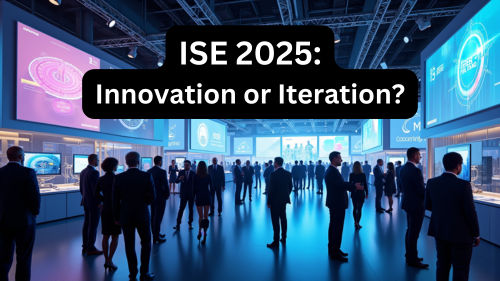More than 35 Meetings in Three Days !!!
ISE is one of my favorite annual events, alongside InfoComm, Enterprise Connect, and a handful of vendor events (Cisco Live, Microsoft Ignite, etc.).ISE 2025 had it all — big vendors, back-to-back meetings, endless steps tracked on my smartwatch, and of course, plenty of networking over great food and wine.
But one thing was missing — game changing innovation.
Trade shows like ISE are where we expect to see groundbreaking announcements—technology that redefines how we work and collaborate. But this year, that wasn’t the case.
The AV World is STILL in an Evolutionary Phase
Sure, at ISE 2025, vendors unveiled new products and features. But were they truly innovative? Or just small, predictable upgrades and me-too products?For better or worse, the professional AV, conferencing, and collaboration market has been in an evolutionary—not revolutionary—innovation phase for several years now.
At ISE 2025, most (but not all) product announcements were evolutionary improvements — small refinements rather than bold redefinitions.
Evolutionary Innovation in Action – What We Saw at ISE 2025
Here’s what evolutionary innovation looks like in practice.- Supporting four cameras instead of three
- Offering 16 ports instead of 12
- Adding three new languages to the 32 languages already supported
- Announcing a less-featured, lower-priced version of a product
- Releasing a “me-too” product simply because every other vendor offers one
- Etc.
Some people may have heard me describe this as vendors “spackling cracks and holes in their product lines.” Well, with a few notable exceptions, that was the game of choice in Barcelona this year.
Why the AV Industry is Focused on Evolutionary Innovation
So, why does it feel like we’re stuck in evolutionary mode? A few key reasons:- After decades of almost non-stop innovation and disruption, the industry is catching its breath.
- The pandemic and its aftermath shifted priorities from ‘what’s next’ to ‘what’s necessary.’
- The transition from a technology-driven market (bits and bytes) to a business-driven one (productivity and outcomes) means innovation is more measured.
- The fact that the providers (Microsoft, Zoom, Google, etc.) have taken over the workflow and UI leaves device vendors fewer opportunities to innovate.
- With MDEP looming on the horizon (we’ll cover MDEP in detail in future posts), some meeting room vendors are hesitant to take bold risks fearing that any breakthrough might be quickly replicated by competitors.
Why Evolutionary Innovation Is Not Failure
Evolutionary innovation is not a bad thing. I say again … evolutionary innovation does not mean we’re failing as an industry. Au contraire.Not everything has to be a head-turner, game-changing release. Some things take time and require a subtle, iterative approach. This is especially true for innovations that impact the real users – not just AV and UC professionals.
Evolutionary innovation also offers key benefits. For example:
- Evolutionary innovation provides stability and predictability – two things that instill confidence in buyers concerned about vendor risk.
- Evolutionary innovation gives vendors time to focus on addressing specific customer needs and pain points, instead of having to complete one development sprint after another just to keep up with their competitors.
The net is that evolutionary innovation may not be sexy, but it’s normal, and even healthy (in small and relatively short doses). Frankly, it’s also understandable given the current market situation.
What’s Next? The Future of Innovation in AV & Collaboration
So, when will we see the next wave of groundbreaking innovation? My bet is in the next 2-3 years, as the industry fully embraces AI, rethinks hybrid work, makes heads or tails out of meeting equity, and shifts from iteration to transformation.[ Don’t worry – I’ll cover some of the interesting things I saw and heard at ISE over the next few weeks. ]
Until then, let’s make the most of this phase—refining, stabilizing, and setting the stage for the next wave of real innovation.

